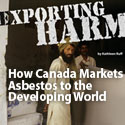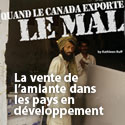An article from the Montreal Gazette on January 30, 2010 highlights the efforts of Kathleen Ruff and Right On Canada to convince the Canadian to ban asbestos.
You can read it below, or click here for the link.
Scientists, MDs, labour groups sound the alarm
By MICHELLE LALONDE, The Gazette – January 30, 2010
Many developed countries around the world, including the EU, have banned asbestos use, but we continue to promote its use abroad.
Canada exported 83 per cent of its asbestos production in 2007. Just over half of that – 145,184 tonnes – went to India, where anti-asbestos protests organized by local labour groups are expected to greet Quebec Premier Jean Charest when he visits next week.
At home, a letter calling for an end to the use and export of asbestos signed by more than 100 scientists from 28 countries was sent to Charest this week, not coincidentally, on the eve of his week-long trade outing to Mumbai, Bangalore and Delhi.
“We appeal to you to respect the overwhelmingly consistent body of scientific evidence and the considered judgment of the World Health Organization (WHO) that all forms of asbestos have been shown to be deadly and that safe use of any form of asbestos has proven impossible anywhere in the world,” the letter said.
It stressed the fact that in Quebec last year, 60 per cent of occupational deaths were caused by asbestos, according to figures from the Quebec Workers’ Compensation Board.
While only three of the scientists who signed that letter are based in Quebec, provincial and national health authorities have been increasingly vocal on the issue.
On Dec. 1, 23 prominent Quebec doctors and health researchers signed a letter to Canada’s Health Minister Leona Aglukkaq asking her to end the mining, use and export of asbestos.
“Exposure to asbestos is the single biggest cause of worker death across Canada,” it said.
“It is inconceivable to us that, in the face of this terrible, continuing and preventable epidemic and public health tragedy in our country, you, as Minister of Health, would continue to reject the call by the Canadian Medical Association, the Canadian Cancer Society, the Canadian Labour Congress, the World Health Organization and the World Federation of Public Health Associations to end the use and export of all forms of asbestos.”
That letter was also signed by the president of the Canadian Association of Physicians for the Environment, the chief executive officer of the Canadian Cancer Society, and about a dozen other environmental and labour union leaders.
The reserves at the open pit mines in Thetford Mines and Asbestos are nearly exhausted. The Lab Chrysotile mine employs about 340 workers in Thetford Mines, while the Jeffrey Mine in Asbestos is opened only sporadically, for a few months at a time, as its resources dwindle.
But the Quebec asbestos industry has pinned its hopes on the potential for a huge new underground mine in Asbestos. The Toronto Star reported last month $130 million has already been invested in that mine. Construction is almost complete, but another $32 million is required to get it up and running. A major Chinese investor recently pulled out of the project, possibly because of Liberal leader Michael Ignatieff’s statement last spring that “export of this dangerous product overseas has got to stop.”
Longtime critic of the asbestos industry Kathleen Ruff, senior human rights adviser for the Rideau Institute on International Affairs, would like to see health authorities in Quebec in general, but in the asbestos mining region in particular, take a stronger stand on the issue.
The recent outcry of doctors in Sept Îles over a proposed uranium mine near their community was a reminder that health officials can play a key role in protecting the public from avoidable environmental health risks, Ruff said.
Twenty doctors threatened to resign en masse last month over concerns the mine project would harm the environment and health of area residents, including their own families. The doctors’ open letter to Quebec’s health minister prompted a massive demonstration in Sept Îles, and the project at Lac Kachiwiss, 14 kilometres north of the Lower North Shore community, is now on hold.
“It is extraordinary and inspiring to see the doctors in Sept Îles taking a stand for public health, rather than agreeing to be silent,” says Ruff, the author of a report called Exporting Harm: How Canada Markets Asbestos to the Developing World, and a longtime critic of Canada’s promotion of chrysotile asbestos.
She contrasts the Sept Îles doctors’ public stance with the culture of silence that has reigned for decades in Thetford Mines and in Asbestos around the health hazards linked to chrysotile asbestos.
Ruff acknowledges it gets much harder for people to speak out, even doctors, when the jobs of family members, friends and neighbours depend on a polluting industry.
“One of the reasons why (the doctors in Sept Îles) are able to speak out when doctors in other areas do not, is that their community’s economy is not based on uranium yet,” she said. “There is not the extreme political pressure on them to stay silent.”
– – –
Because of the health risks, asbestos is rarely used in Canada – we export about $100 million worth a year
Asbestos is a naturally occurring mineral that is mined in only two places in Canada – Thetford Mines and Asbestos, both in Quebec.
Because of its heat and fire-resistant properties, asbestos has been used for roofing, as thermal and electrical insulation, or mixed with cement to make pipes, sheets, flooring and other products.
When asbestos fibres are breathed in by humans over long periods, they can cause deadly diseases such as asbestosis (a chronic inflammatory lung condition), mesothelioma (a type of lung cancer) and other forms of cancer.
In 2004, Statistics Canada reported 134 new cases of mesothelioma in Quebec, and the the Institut national de santé publique du Québec reported 211 cases of asbestosis in the same year. Studies have shown that for every case of mesothelioma, asbestos causes two to three times as many cases of lung cancer. This would put Quebec at a total of 613 new cases of asbestos-related disease in 2004 alone.
Worldwide, an estimated 100,000 workers die every year from diseases caused by exposure to asbestos.
Because of the proven health risks, and despite the Quebec government’s official policy to promote its use domestically, asbestos is rarely used in Canada. It is, in fact, being removed at great public expense from many schools and public institutions, including the Parliament Buildings in Ottawa. But we still export about $100-million worth of asbestos a year to developing nations.
There are two types of asbestos: serpentine (which includes chrysotile) and amphiboles. Some research suggests the amphiboles types are more dangerous to humans. But both types of asbestos are designated carcinogens by the Environmental Protection Agency and the World Health Organization.
MICHELLE LALONDE



Wed, Feb 3, 2010
In the media